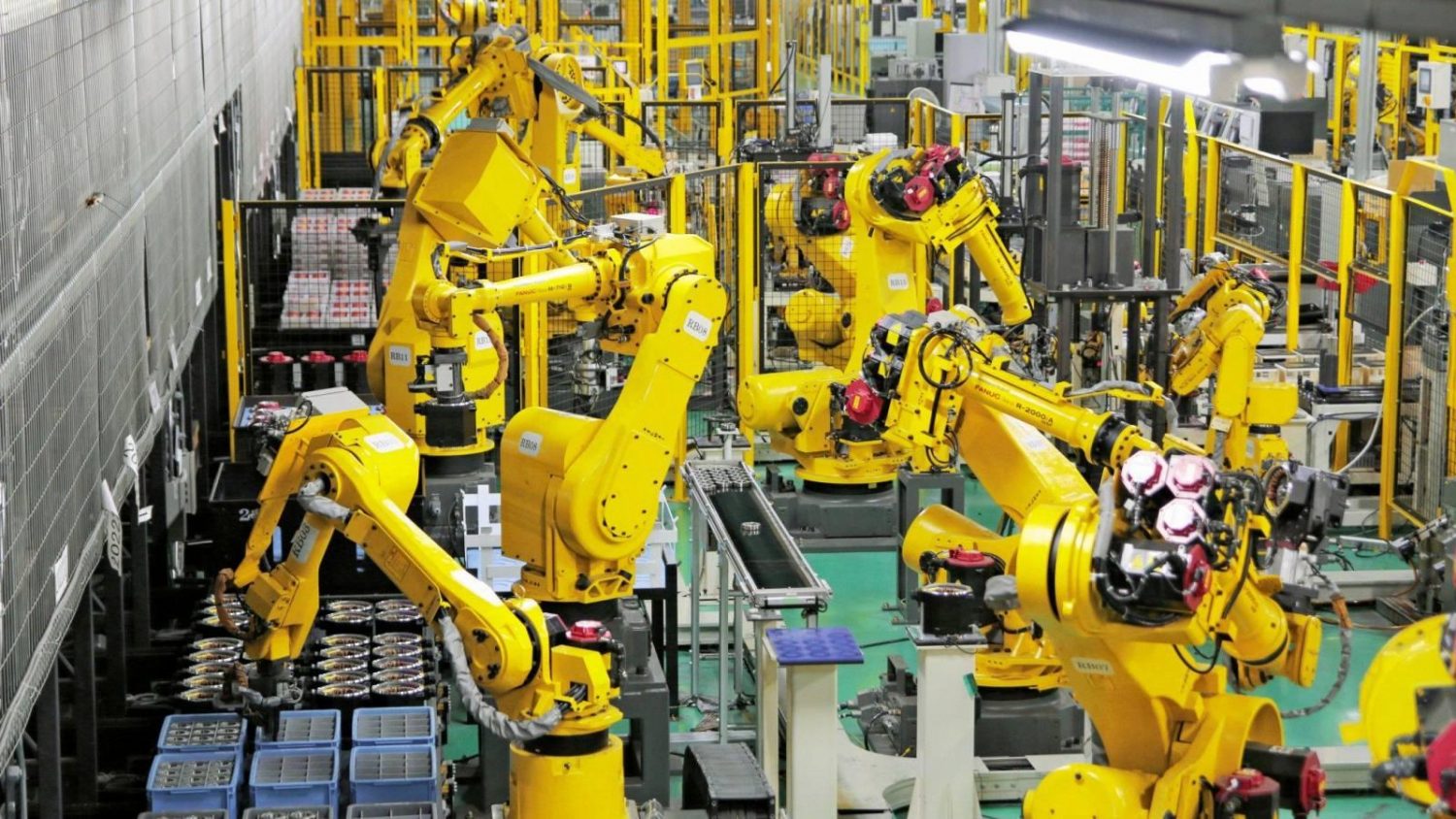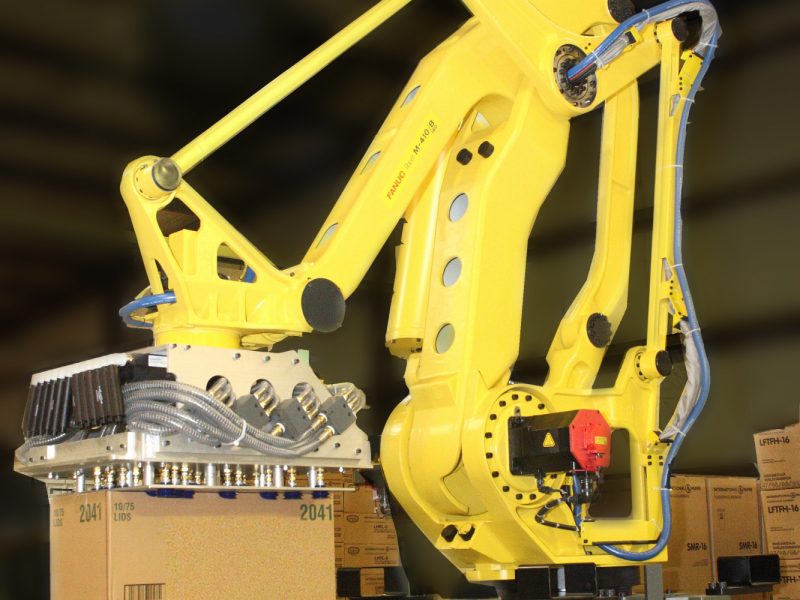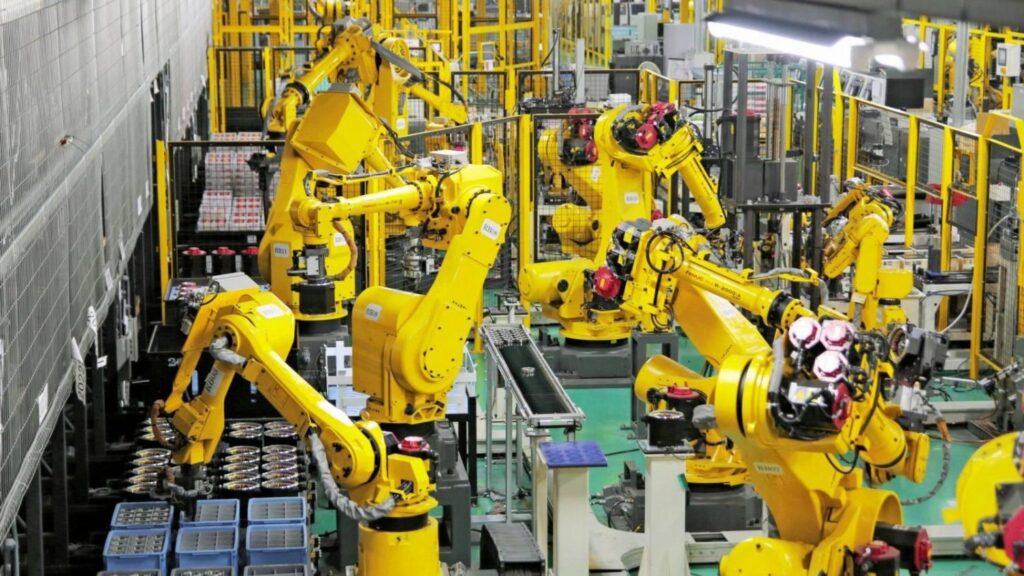
Montana Robotics Integration
Industrial, Factory and Palletizing Robots

First, let’s correct some common misconceptions about industrial industrial robots.
They Are Not AI Or Terminators. Contrary to what Hollywood may portray, industrial robots are not humanoid AI terminators. Instead, they are highly programmable mechanical arms designed to perform specific tasks with precision and efficiency.
Industrial robots are often mistaken for artificial intelligence (AI) due to their advanced capabilities, but in reality, they operate based on custom programming tailored to specific tasks. Unlike AI systems that can adapt and learn from experience, industrial robots rely on pre-defined instructions to execute tasks with precision and efficiency. These machines excel in repetitive and structured environments where consistency is key, making them indispensable in manufacturing and assembly lines. While they may incorporate sensors and other technologies for feedback, their actions are predetermined by human programmers, highlighting the distinction between automation and artificial intelligence.
They Are Not Taking Away Jobs. Robots are often misunderstood as being replacements for human workers, leading to fears about job loss. However, it’s important to recognize that robots are not designed to take jobs from humans but rather to enhance and complement human capabilities in various industries.
Similar to excavators significantly increasing efficiency in digging tasks. Without an excavator, it would take a team of 20 people to dig a ditch in the same amount of time. However, by enabling a human operator to control this piece of equipment, the back-breaking manual labor of digging is made significantly easier. This not only increases efficiency but also reduces the risk of injuries associated with labor-intensive tasks.
Robots take on these labor-intensive tasks and prevent workers’ compensation claims, downtime, and associated expenses such as increases in insurance premiums. Unlike humans, robots can perform these tasks tirelessly and consistently, without succumbing to fatigue or strain. This not only improves workplace safety but also reduces the financial burden on employers caused by injuries and their associated costs.
By leveraging the strengths of both humans and robots, businesses can create safer, more efficient work environments that benefit everyone involved. Instead of fearing job loss, it’s time to embrace the potential of robotics to revolutionize the way we work for the better while saving money and ensuring the well-being of employees.


Robotics Integration IS Cost Effective. The cost comparison between employing a human worker and investing in robotics integration for tasks like stacking 50lb feed bags on pallets reveals significant advantages for businesses.
While a human worker may demand a high hourly wage for a labor intensive task, the expenses extend beyond just the hourly rate. Labor costs include factors like workers’ compensation, associated expenses, vacation pay, and the potential for inefficiencies due to fatigue, injuries, or turnover. Additionally, humans typically work an 8-hour shift but might only perform effectively for around 6 hours. In contrast, robotics integration enables the deployment of industrial robots that can operate 24/7 without fatigue, ensuring consistent performance and higher efficiency. With faster speed and precision, a robot can outperform any human counterpart in such repetitive and labor-intensive tasks.
Moreover, the nature of these jobs often makes them undesirable for human workers, leading to recruitment challenges. Therefore, depending on the volume of work, the return on investment from implementing robotics integration could be realized in less than a year, making it a financially sound decision for businesses aiming to optimize productivity and reduce operational costs.
What is Robotics Integration
Robotics integration refers to the process of connecting a robot into an existing system and providing it with the capability to interact seamlessly within that process. In manufacturing or industrial settings, a robot rarely operates in isolation. The items it handles typically come from an automated process, and the products it places usually need to move on to another stage in the production line.
Integration involves linking the robot with sensors, controllers, and other automation devices to enable real-time data exchange and coordination. Through this integration, the robot can receive signals or feedback from the surrounding environment, such as detecting the presence of objects or monitoring the status of designated areas, allowing it to make informed decisions and execute tasks accurately.
By seamlessly integrating a robot into an existing system, businesses can enhance productivity, reduce cycle times, and improve overall operational efficiency. The ability of the robot to interact within the process ensures smooth workflow transitions and enables the system to adapt to changing production demands effectively. Robotics integration plays a vital role in harnessing the full potential of automation technology and optimizing manufacturing processes for increased competitiveness and success.


Facts About Industrial Robots
- The repeatable accuracy of a robot’s movement is astounding, as precise as 1/100 of the thickness of a human hair. This level of precision allows robots to pick up and place objects with unmatched consistency.
- Robots’ speed capabilities are equally impressive, with the ability to move as fast as a human swinging a bat. However, the speed at which a robot operates must be realistic based on the weight and dynamics of the items being handled. Safety considerations, such as inertia and the potential impact on the surrounding environment, need to be taken into account when determining the speed of movement.
- Industrial robots have the capacity to handle items weighing up to one ton, making them invaluable assets in manufacturing and warehousing environments.
- With proper maintenance, an average industrial robot can operate continuously for 20 years. This maintenance includes regular lubricant changes, periodic accuracy testing, and ensuring all mechanical components are in optimal working condition. Regular checks on joint lubrication, torque on nuts and bolts, and the stability of pick and place points are essential to ensure the robot’s longevity and performance.
Robots Save Workers From Injuries and Employers From Claims
Industrial robots play a crucial role in preventing both workers and employers from the perils associated with workplace injuries, thereby curbing workers’ compensation claims. By substituting humans in perilous tasks, robots significantly diminish the probability of various workplace injuries, including repetitive motion injuries (RMIs), musculoskeletal disorders (MSDs), among others. Injuries stemming from repetitive motions, heavy lifting, and awkward postures, are prevalent in industrial settings. However, by automating repetitive tasks and heavy lifting through robotics, employers can effectively eliminate the risk of RMIs among their workforce.
Moreover, robots are adept at handling tasks involving exposure to hazardous materials or environments, such as toxic chemicals, extreme temperatures, or radiation, which pose serious health risks to human workers. These risks encompass chemical burns, respiratory issues, and radiation sickness. With robots equipped with specialized sensors and protective casings, employers ensure that these tasks are executed safely without endangering human health. Additionally, robots excel in working in confined spaces or high-risk areas, like construction sites or manufacturing plants, where human workers might be susceptible to falls, crush injuries, or being struck by heavy machinery.
Beyond physical injuries, industrial robots also mitigate the risk of occupational accidents arising from human error or fatigue. Human operators may occasionally make errors due to fatigue, distraction, or lack of concentration, leading to accidents like equipment malfunctions, collisions, or falls. By automating these tasks, employers eradicate the human element, thus diminishing the likelihood of accidents and subsequent workers’ compensation claims. Overall, the integration of industrial robots into the workforce not only enhances productivity and efficiency but also fosters a safer working environment for all stakeholders involved.
Why use us for your robotics integration project?
When it comes to robotics integration projects, Archenergy – Montana’s Robotics Integration & Automation Services stands out as a top choice for businesses seeking expertise and comprehensive service. With years of experience in the field, we go beyond the typical robot installation process.
We understand that our clients shouldn’t have to navigate the complexities of operating the robot from its pendant. That’s why we offer a personalized solution: a customized touch screen interface specifically programmed for the task at hand. By simplifying the user experience, we ensure seamless integration into your production or process.
As both an automation company and a full-service systems integrator, we offer end-to-end solutions tailored to your needs. From design to programming and installation, we handle every aspect of the project with precision and efficiency.
Our approach minimizes downtime by first setting up and testing the system in our shop, ensuring it operates flawlessly before installation onsite. Additionally, we take care of essential components like installing safety cages around the robot and designing and building custom end-of-arm tooling.
Whether you require standard installations or custom solutions, our team is equipped to deliver results that exceed expectations. With Archenergy – Montana’s Robotics Integration & Automation Services, you can trust that your robotics integration project is in capable hands, allowing you to focus on what matters most—your business.